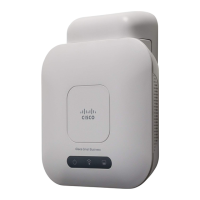LAN
IPv6 Tunnel
Cisco WAP571/E Administration Guide 68
4
• IPv6 Link Local Address—The IPv6 address used by the local physical link.
The link local address is not configurable and is assigned by using the IPv6
Neighbor Discovery process.
• Default IPv6 Gateway—The statically configured default IPv6 gateway.
• IPv6 Domain Name Servers—Select one of the following options:
- Dynamic—The DNS name servers are learned dynamically through
DHCPv6.
- Manual—Manually specify up to two IPv6 DNS name servers in the fields
provided.
STEP 3 Click Save. The changes are saved to the Startup Configuration.
NOTE After new settings are saved, the corresponding processes may be stopped and
restarted. When this condition happens, the WAP device may lose connectivity. We
recommend that you change the WAP device settings when a loss of connectivity
will least affect your wireless clients.
IPv6 Tunnel
The WAP571/E device supports the Intra-Site Automatic Tunnel Addressing
Protocol (ISATAP). ISATAP enables the WAP device to transmit IPv6 packets
encapsulated within IPv4 packets over the LAN. The protocol enables the WAP
device to communicate with remote IPv6-capable hosts even when the LAN that
connects them does not support IPv6.
The WAP device acts as an ISATAP client. An ISATAP enabled host or router must
reside on the LAN. The IP address or hostname of the router is configured on the
WAP device (by default, it is isatap). If configured as a hostname, the WAP device
communicates with a DNS server to resolve the name into one or more ISATAP
router addresses. The WAP device then sends solicit messages to the router(s).
When an ISATAP-enabled router replies with an advertisement message, the WAP
device and router establish the tunnel. The tunnel interface is assigned a link-local
and a global IPv6 address, which serve as virtual IPv6 interfaces on the IPv4
network.
When IPv6 hosts initiate communication with the WAP device connected via the
ISATAP router, the IPv6 packets are encapsulated into IPv4 packets by the ISATAP
router.

